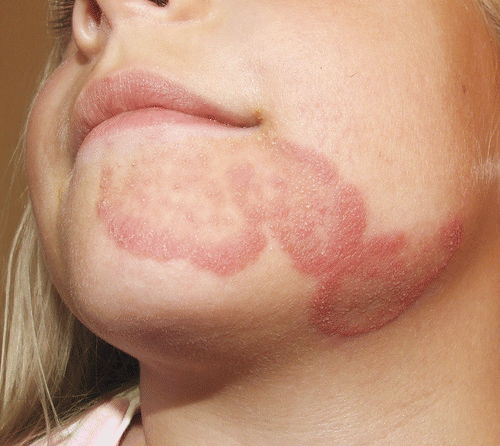Tinea Faciei Causes, Symptoms, Diagnosis and Treatment

What is Tinea Faciei?
Tinea faciei is a superficial infection of the skin. It is part of the dermatophyte skin infections and it can affect people of different sexes and ages. In children and in women, tinea faciei affects the skin on the face, including the chin and the upper lip. In the male population, this infection is known as tinea barbae, as it occurs only on areas that have hair (such as the beard area).
Causes of Tinea Faciei
These are the most common causes of tinea faciei:
- Fungal infection – zoophilic dermatophytes (Microsporum canis).
- Acquired infection from pets or livestock.
- Transmission from one person to the other is possible, as the lesions are highly contagious to the touch.
- In Asia – common infections with Trichophyton mentagrophytes and Trichophyton rubrum.
- In North America – common infection with Trichophyton tonsurans.
Symptoms of Tinea Faciei
The most common locations for tinea faciei include the following:
- Cheeks
- Nose
- Around the eye
- Chin
- Forehead
Tinea faciei appears as one or more pink-to-red scaly patches ranging in size from 1 to 5 cm. The border of the affected skin may be raised and may contain bumps, blisters, or scabs. Often, the center of the lesion has normal-appearing skin with a ring-shaped edge, leading to the nickname “ringworm,” even though it is not caused by a worm.
Facial ringworm can be itchy, and it may get worse or feel sunburned after exposure to the sun.
Diagnosis of Tinea Faciei
To confirm the diagnosis of facial ringworm, your physician might scrape some surface skin materials (scales) onto a glass slide and examine them under a microscope. This procedure, called a KOH (potassium hydroxide) preparation, allows the doctor to look for tell-tale signs of fungal infection.
Treatment of Tinea Faciei
Once the diagnosis of facial ringworm is confirmed, your physician will probably start treatment with an antifungal medication. Most infections can be treated with prescription-strength topical creams and lotions, including:
- Terbinafine
- Clotrimazole
- Miconazole
- Econazole
- Oxiconazole
- Ciclopirox
- Ketoconazole
- Sulconazole
- Naftifine
Rarely, more extensive or long-standing infections may require treatment with oral antifungal pills, including:
- Terbinafine
- Itraconazole
- Griseofulvin
- Fluconazole
Related Articles:
Melasma Causes, Symptoms, Diagnosis and Treatment
Oedema Causes, Symptoms, Diagnosis and Treatment
Tinea Pedis Causes, Symptoms, Diagnosis and Treatment
Thrombophlebitis Causes, Symptoms, Diagnosis and Treatment
Thrombocytopenia Causes, Symptoms, Diagnosis and Treatment
Torticollis Causes, Symptoms, Diagnosis and Treatment
Eczema Causes, Symptoms, Diagnosis and Treatment
Toxic Shock Syndrome Causes, Symptoms, Diagnosis and Treatment
Tarsal Cyst Causes, Symptoms, Diagnosis and Treatment
By : Natural Health News




